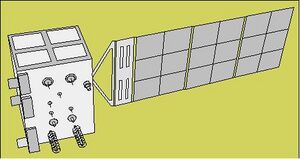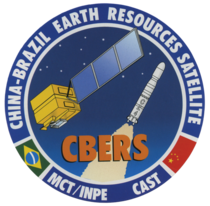Engineering:CBERS-1
 Line drawing of the CBERS/ZY-1 spacecraft | |
| Mission type | Remote sensing |
|---|---|
| Operator | CNSA / INPE[1] |
| COSPAR ID | 1999-057A |
| SATCAT no. | 25940 |
| Website | CBERS |
| Mission duration | 2 years[2] |
| Spacecraft properties | |
| Spacecraft type | CBERS |
| Bus | Phoenix-Eye 1[1] |
| Launch mass | 1,450 kg (3,200 lb)[2] |
| Power | 1,100 watts[2] |
| Start of mission | |
| Launch date | 14 October 1999, 03:15 UTC[3] |
| Rocket | Chang Zheng 4B |
| Launch site | Taiyuan LC-7 |
| End of mission | |
| Disposal | Decommissioned |
| Deactivated | September 2003[4] |
| Orbital parameters | |
| Reference system | Geocentric |
| Regime | Sun-synchronous |
| Semi-major axis | 7,153.45 km (4,444.95 mi) |
| Eccentricity | 0.0004025 |
| Perigee altitude | 779 km (484 mi) |
| Apogee altitude | 785 km (488 mi) |
| Inclination | 98.34 degrees |
| Period | 100.35 minutes |
| Epoch | 30 November 2013, 20:57:46 UTC[5] |

| |
China–Brazil Earth Resources Satellite 1 (CBERS-1), also known as Ziyuan I-01 or Ziyuan 1A (ZY 1,[6] ZY 1A), is a remote sensing satellite which was operated as part of the China–Brazil Earth Resources Satellite program between the China National Space Administration and Brazil 's National Institute for Space Research.[1] The first CBERS satellite to fly, it was launched by China in 1999.[3]
CBERS-1 was a 1,450 kg (3,200 lb) spacecraft built by the China Academy of Space Technology and based on the Phoenix-Eye 1 satellite bus.[1] The spacecraft was powered by a single solar array, providing 1,100 watts of electricity for the satellite's systems.[2][7] The instrument suite aboard the CBERS-1 spacecraft consisted of three systems: the Wide Field Imager (WFI) produced visible-light to near-infrared images with a resolution of 260 metres (850 ft) and a swath width of 890 km (550 mi); a high-resolution CCD camera was used for multispectral imaging at a resolution of 20 metres (66 ft) with a swath width of 113 km (70 mi); the third instrument, the Infrared Multispectral Scanner (IMS), had a resolution of 80 metres (260 ft) and a swath width of 120 kilometres (75 mi).[8]
A Chang Zheng 4B carrier rocket, operated by the China Academy of Launch Vehicle Technology, was used to launch CBERS-1. The launch took place at 03:15 UTC on 14 October 1999, using Launch Complex 7 at the Taiyuan Satellite Launch Centre.[3] The satellite was successfully placed into a Sun-synchronous orbit.
CBERS-1 was decommissioned in September 2003, almost four years after launch.[4] The derelict satellite remains in orbit; as of 30 November 2013 it is in an orbit with a perigee of 779 km (484 mi), an apogee of 785 km (488 mi), 98.34 degrees inclination and a period of 100.35 minutes. The orbit has a semimajor axis of 7,153.45 km (4,444.95 mi), and eccentricity of 0.0004025.[5]
References
- ↑ 1.0 1.1 1.2 1.3 Krebs, Gunter. "CBERS 1, 2, 2B / ZY 1A, 1B, 1B2". Gunter's Space Page. http://space.skyrocket.de/doc_sdat/cbers-1.htm. Retrieved 1 December 2013.
- ↑ 2.0 2.1 2.2 2.3 "CBERS-1 (China-Brazil Earth Resources Satellite) - 1st Generation Satellite Series". Earth Observation Portal. European Space Agency. https://directory.eoportal.org/web/eoportal/satellite-missions/c-missions/cbers-1-2. Retrieved 1 December 2013.
- ↑ 3.0 3.1 3.2 McDowell, Jonathan. "Launch Log". Jonathan's Space Page. http://planet4589.org/space/log/launchlog.txt. Retrieved 1 December 2013.
- ↑ 4.0 4.1 "Civil Commercial Imagery Evaluation Workshop". United States Geological Survey. 2007. http://calval.cr.usgs.gov/JACIE_files/JACIE07/Files/112Siilva.pdf. Retrieved 1 December 2013.
- ↑ 5.0 5.1 "CBERS 1 Satellite details 1999-057A NORAD 25940". N2YO. 30 November 2013. http://www.n2yo.com/satellite/?s=25940. Retrieved 1 December 2013.
- ↑ "Display: CBERS 1 1999-057A". NASA. https://nssdc.gsfc.nasa.gov/nmc/spacecraft/display.action?id=1999-057A.
 This article incorporates text from this source, which is in the public domain.
This article incorporates text from this source, which is in the public domain.
- ↑ "CBERS-1, 2 and 2B Description". INPE. http://www.cbers.inpe.br/ingles/satellites/description_cbers1_2_2b.php. Retrieved 1 December 2013.
- ↑ "CBERS-1, 2 and 2B Cameras". INPE. http://www.cbers.inpe.br/ingles/satellites/cameras_cbers1_2_2b.php. Retrieved 1 December 2013.
 |

